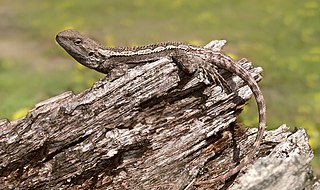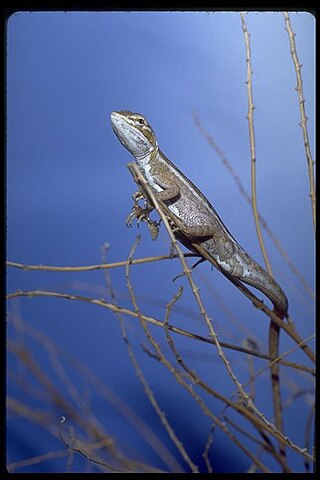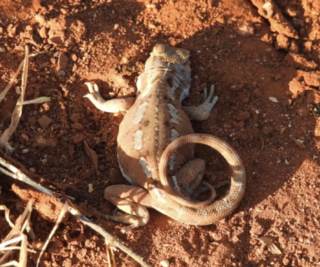
Amphibolurus is a genus of lizards in the family Agamidae. The genus is endemic to Australia.

Ctenophorus is a genus of lizards, commonly known as comb-bearing dragons, found in Australia. They are in the dragon lizard family, known as Agamidae.

Diporiphora is a genus of lizards in the family Agamidae. Most species in the genus are endemic to Australia, but two are also found in New Guinea.

The eastern bearded dragon, also known as common bearded dragon or simply bearded lizard, is an agamid lizard found in wooded parts of Australia. It is one of a group of species known commonly as bearded dragons. Other common names for this species include Jew lizard and frilly lizard, the latter being a confusion between this and another dragon, the frill-necked lizard. This species was originally described in 1829 by Georges Cuvier, who named it Amphibolurus barbatus.

The jacky dragon is a type of lizard native to south-eastern Australia. Other common names include blood-sucker, stonewalker, and tree dragon. It was one of the first Australian reptiles to be named by Europeans, originally described by English zoologist George Shaw in Surgeon-General John White's Journal of a Voyage to New South Wales, published in London in 1790. The lizard is well-known for its bright yellow mouth and well-developed vertebral crest, as well as the temperature-dependent sex determination of its offspring.

Ctenophorus pictus, commonly known as the painted ground-dragon or painted dragon, is a species of lizard from the family Agamidae. It is endemic to the drier areas of southern and central Australia.

The northern spiny-tailed gecko is a species of lizard in the family Diplodactylidae. The species is endemic to Australia.

Diporiphora winneckei, also known commonly as the canegrass dragon, canegrass two-line dragon, blue-lined dragon, and Winnecke's two-pored dragon, is a species of small, terrestrial, diurnal lizard in the family Agamidae. The species is endemic to Australia. It is found throughout arid zones of Australia and is also a common house pet.
The gibber earless dragon also known as the smooth-snouted earless dragon, is a species of agamid lizard endemic to Australia. It is one of a documented species of the genus Tympanocryptis, a group of small terrestrial lizards that feed off invertebrates and are characterised by the absence of an external ear structure.

The Mallee dragon, also commonly known as the Mallee dragon and the Mallee sand-dragon, is a species of lizard in the family Agamidae. The species is native to the arid parts of southern Australia.

Ctenophorus rubens, commonly known as the reddening sand-dragon or rufus sand dragon, is a species of agamid lizard occurring in the arid sandy areas of shrublands and spinifex of the Exmouth Gulf and the adjacent interior of Western Australia, with an isolated population also occurring in the sand dunes south of Hamelin Pool, Western Australia. It was formerly considered to be a subspecies of C. isolepis.

Ctenophorus butlerorum, also known commonly as Butler's dragon, the Shark Bay heath dragon and the Edel heath dragon, is a species of lizard in the family Agamidae. The species is endemic to Australia.
Ctenophorus mckenziei, more commonly known as the dwarf-bicycle dragon, is a species of endemic Australian lizard within the family Agamidae and genus Ctenophorus. Originally identified as the agamid Amphibolurus mckenziei, the lizard had been identified within the regions of Western Australia and South Australia in which it occupied the shrubbery and woodland areas as its habitat. It was subsequently transferred to the genus Ctenophorus along with other Agamid species in which it shared similar morphology and characteristics. The name mckenziei is in reference to Norman Leslie Mckenzie, who was a zoologist and discovered the existence of the lizard. Listed on the IUCN red list page, threats to its population numbers are evaluated as least concern; however, their numbers are threatened by habitat loss, climate change, and feral predators.

Ctenophorus parviceps, commonly known as the Gnaraloo heath dragon or northwestern heath dragon is a species of agamid lizard occurring in pale coastal sands and shell grit with open heaths and beach spinifex, between the North West Cape and Carnarvon, Western Australia and on Bernier Island. The Gnaraloo heath dragon is a lizard that can be found along the coast of Western Australia between Exmouth Gulf and Shark Bay, and is also known as the northwestern heath dragon. It is native to Australia and usually inhabits sandy coastal dunes. The species' longevity is 3–50 years and its population density is extremely low. The Gnaraloo heath dragon is a member of the Agamidae family, which contains 15 genera. The lizard is under the Ctenophorus genus which has up to 33 species. This genus shows the most morphological and ecological diversity out of the three large agamid genera. 83% of the lizards in this genus lack a crest, while 17% possess crests. They are smaller than most agamids but do have relatively large heads. The Gnaraloo heath dragon can be differentiated from related species by a series of spines on the tail's base, a pale-grey brown broad vertebral band along its back, and hour-glass bars extending upwards to meet the pale vertebral band. It is usually 45mm in terms of length, measuring from snout to vent.

Gowidon is a genus of arboreal lizards in the family Agamidae. It is monotypic with a single recognised species, Gowidon longirostris, commonly known as the long-snouted lashtail or long-nosed water dragon. It is found in Northern Territory, Queensland, South Australia, Western Australia, Australia, and in New Guinea.

Tropicagama is a genus of large-bodied lizards in the family Agamidae. The genus is monotypic, with only one species listed: Tropicagama temporalis, commonly known as the swamplands lashtail or northern water dragon. This semi-arboreal species inhabits the tropical savannah woodlands of northern Australia, as well as parts of New Guinea and southeastern Indonesia.

The Mallee heath dragon, is a species of semi-Arboreal Agamidae endemic to Australia. it has also been referenced as Norris’s dragon, Mallee heath lashtail and Mallee heath lashtail dragon.
Diporiphora bennettii, also known commonly as the Kimberley sandstone dragon or the robust two-line dragon, is a species of lizard in the family Agamidae. The species is endemic to Australia.

Diporiphora lalliae, also known commonly as Lally's two-line dragon and the northern deserts dragon, is a species of lizard in the family Agamidae. The species is endemic to Australia.

Lophognathus gilberti, also known commonly as Gilbert's dragon, Gilbert's lashtail, or Ta-ta lizard, is a species of lizard in the family Agamidae. The species is endemic to Australia.


















